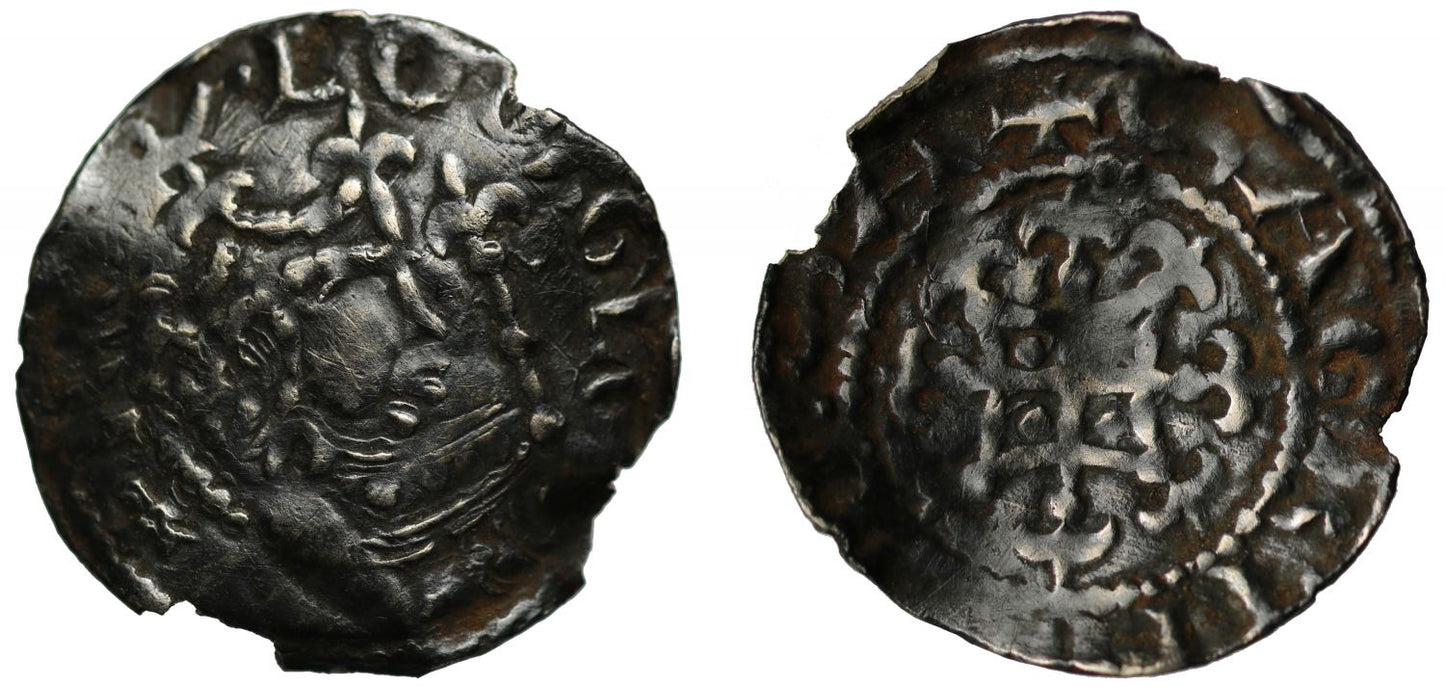FAQs
What makes a coin valuable?
I have coins to sell, what’s the next step?
How will my purchases be shipped?
What happens if I’m not entirely happy with my purchase?
Baronial Penny, Earl Robert of Gloucester, Shaftesbury Mint, Moneyer Sagrim
Stephen (1135-54), silver Baronial Penny, Angevin Party, Earl Robert of Gloucester, style of Watford type (c.1141-45), Shaftesbury Mint, Moneyer Sagrim, crowned bust with sceptre right, legend and beaded border surrounding, commencing lower left, +ROB COM gLO, rev. quadrilateral over cross fleury within beaded circle, legend and beaded border surrounding, +SAGRIM: ON : SA:, the first S prone, weight 0.89g (BMC p.395; Allen, BNJ 2012, p.114; N.-; S.1334A). Dark tone, coin a little dished with some rim chips, otherwise very fine for issue with clear design elements and visible readings, unique, the only example known and available.
The legends translate as "Robert Comes" meaning Duke/count/Earl Robert on obverse and "Sagrim of Shaftesbury" on the reverse.
The reign of Stephen is perhaps one of the most interesting numismatically as England descends towards Civil War in the latter part of the reign, with an increasing volume in types of coinage with many poorly struck as allegiances to the King, the Empress or the various noblemen wax and wane. The first so-called Watford type is the most abundant due to the fact that a major hoard of this type turned up in the Watford area in Victorian times, rather than something describing the design, but a well struck piece is hard to find.
North records two moneyers including Sagrim working at Shaftesbury for Stephen in type one only.
Often referred to as Stephen of Blois he was born in either 1092 or 1096 he was a younger son of Stephen-Henry the Count of Blois who died whilst Stephen was young, he subsequently being raised by his mother Adela the daughter of William the Conqueror. He was placed into the English court of his uncle Henry Beauclerc, where he rose in prominence and was granted extensive lands, he became Count of Boulogne by his marriage in 1125 to Matilda inheriting estates there and in Kent making the couple one of the wealthiest in England. He had earlier escaped drowning in the White Ship disaster of 1120 which claimed the life of William Aethling the son of Henry I, leaving some doubt over the succession to the English throne despite Henry nominating his daughter Matilda as heir. Later, upon the news of Henry's passing on 1st December 1135, Stephen immediately crossed over the English Channel and with the help of his brother Henry Bishop of Winchester and Abbot of Glastonbury he took the throne declaring the preservation of order across the Kingdom took priority over any earlier oaths to support his cousin Empress Matilda. His early years were successful ones despite some attacks in the north from David I of Scotland, from Welsh rebels in the west and from Empress Matilda's husband Geoffrey from the east. In 1138 Robert of Gloucester the half-brother of Empress Matilda rebelled threatening civil war. Stephen fiercely defended his rule with support from Waleran de Beaumont, arresting a group of bishops. However, in 1139 when the Empress and Robert of Gloucester invaded Stephen was unable to crush the revolt with them taking hold of the south-west of England. Stephen was captured at the Battle of Lincoln in 1141, lost Normandy and abandoned by many of his followers, but was subsequently released after his wife Matilda with William of Ypres captured Robert at the Rout of Winchester, but the civil war continued to drag on unabated. Stephen wanted his son Eustace to succeed him and tried to convince the church to crown Eustace in advance, but Pope Eugene III refused causing disruption within the clergy. In 1153 Empress Matilda's son Henry invaded building a powerful alliance of barons to support him for the throne. The armies met at Wallingford with neither side keen to fight and negotiations began to find peace hastened by the sudden death of Eustace on the 17th August at Bury St Edmunds, and resulting in the Treaty of Winchester where Stephen recognized Henry as heir. Stephen passed away on 25th October 1154 from a stomach disease whilst at Dover and is buried at Faversham Abbey.
Situated in Dorset nearly 25 miles north northwest of Dorchester on high ground, Shaftesbury is where Dunstan took the body of Edward the Martyr for interment after his death at Corfe Castle. Minting activity occurs from the reign of Aethelstan to King Stephen including a die link with the rare "BRYGIN" pieces.
Provenance:
Portable Antiquities Scheme: WILT-239A33 record created 25th June 2019.
Ex Dix Noonan and Webb, Auction 169, 12th February 2020, lot 259.
Ex Collection of an English Doctor part II, Sovereign Rarities fixed price list online May 2022.
FAQs
What makes a coin valuable?
I have coins to sell, what’s the next step?
How will my purchases be shipped?
What happens if I’m not entirely happy with my purchase?













